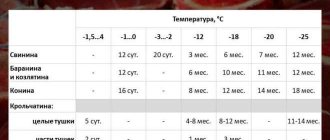How to properly store beer is of interest not only to specialists. The drink is considered simple and is not usually treated with much attention; this is a completely reckless opinion. Failure to comply with recommended storage conditions may result in a spoiled product.
Some stouts or porters can go bad within a few hours. When purchasing a large quantity of a drink, you should take care in advance of proper storage and create the most suitable conditions for it.
What determines the shelf life of beer?
“Different beers are stored differently. For example, there are varieties that can be stored for several years. Such drinks will ripen in the same way as wine. And it all depends on the purity of the bottling and the degree of contamination of the beer itself during the production process. Contamination does not mean there is any dirt in the beer. Beer is a fairly complex product into which yeast is added, but even the yeast itself may be slightly contaminated upon purchase. As a result, there may be too few active yeast cells left to quickly start the fermentation process, and during the production of the drink, a process of contamination of the wort may occur,” says brewery owner Pavel Olshansky .
The shelf life of beer also depends on the container. According to GOST, factory beer is bottled in glass bottles, aluminum cans, plastic bottles and kegs. Live (unpasteurized) beer is usually stored in kegs, while pasteurized or filtered beer is stored in plastic and glass bottles or aluminum cans.
How long can homemade beer last?
Ardent fans of weak alcohol brew it at home. But this raises many questions about shelf life. Quality and suitability depend on several factors:
- Complete sterility during production.
- The most suitable container for the drink and tight sealing.
- Type of product produced.
- Storage conditions.
The shelf life of live beer produced in a factory is determined by a month. Thanks to an individual approach, home production increases shelf life significantly. Experienced manufacturers are confident that proper sterility will allow the drink to mature for up to six months.
For basic technological processes, the recommended maturation time is one month. If all sterility requirements are met, the aging period increases to three months.
. The result is a superb live brew that will be the envy of any production brewer.
How long can beer be stored in kegs?
The shelf life of draft beer in kegs is very long. It can stay in such a closed container for up to six months, and sometimes longer. Thus, live beer that has not undergone pasteurization and filtration is stored for up to one month, pasteurized - from 30 to 120 days.
Article on the topic
Is there a beer culture in Russia? 5 mistakes in drinking an intoxicating drink “Everything will depend on what kind of beer is poured and where it is located. Very often in bars, beer is placed next to a cooler, from which hot air blows. And if it blows directly onto the keg, then most likely any beer will go bad within a week. If the keg is in the refrigerator, then in general almost any beer will live there for a month. Maybe longer, it all depends on the degree of infection. The shelf life of beer can also be shortened if it is poured into a reusable keg that has not been thoroughly washed beforehand. Accordingly, beer will be stored for less time, since an infection process will occur, improper fermentation processes will begin, and the drink will begin to deteriorate,” says Olshansky.
Once the keg has been opened, it is best to consume its contents within three days. If this period is exceeded, the taste of the drink will change and the beer will taste sour.
Signs of a low-quality product
After expiration and storage, the foamy drink is dangerous to the health of consumers. Unscrupulous sellers may hide the true shelf life and offer stale goods.
The spoiled product will have the following differences:
- The appearance of sediment at the bottom of the bottle.
- Weigh, flakes.
- Increased turbidity, which is not provided for by this type of production.
- The appearance of a sour smell.
- Sourish taste.
- A stale product may have no foam at all or may form too much foam.
When purchasing, you also need to pay attention to the appearance of foam during the spill. In a fresh drink, it is thick, dense and can last up to 3 minutes.
Thus, draft beer is not a long-term storage product. You shouldn't stock up on them for future use. And if you want to try a fresh foamy drink at a bar, then it is better to choose an establishment with the highest traffic. Only in this case can you count on fresh beer.
How long can beer be stored in plastic bottles?
The shelf life of beer bottled in plastic bottles also ranges from six months to one year. It is not recommended to store “live” draft beer in plastic bottles for a long time, since every hour it loses its taste and usefulness due to exposure to air and light. The maximum time during which such beer should be consumed is three days, subject to storage rules. This short period is due to the fact that when bottled the drink comes into contact with air; the bottle is not airtight and not sterile.
Persistent foam and bitterness in the aftertaste. How to choose the perfect beer? More details
How to determine the freshness of beer
First of all, to ensure your beer lasts as long as possible, pay attention to its freshness. If you buy draft varieties, ask the seller how long ago the keg was opened. If this period does not exceed a week, you can buy the drink without fear that it will be spoiled. Otherwise, a characteristic white precipitate appears in the liquid. It gives the product an unpleasant sour taste.
If the seller is unverified, take a closer look at the quality of the foam. If it blows off easily, the product is spoiled. Good foam will last a long time and will leave marks on the walls of the container.
If you prefer beer in original packaging, take a closer look at the bottle (can) and label. The container must be smooth and uniform in color, without flaws. If the drink bubbles under the lid, it means the container has been opened, and consuming such a product is extremely dangerous. The label must contain information about the manufacturer, storage standards, and composition. There must be a barcode and a warning about excessive alcohol consumption.
Optimal temperature and humidity
Temperature and humidity indicators significantly affect how long beer will be stored. And if, regardless of the variety, it is recommended to maintain humidity at 85%, then the optimal temperature will depend on the strength of the drink. The stronger the beer, the higher the temperature it can withstand without changing its taste:
- strong varieties – from +12 to +15⁰С;
- varieties with average alcohol content – from +10 to +12⁰С;
- low-alcohol varieties – from +7 to +10⁰С.
Live unpasteurized beer retains its properties at +20… +25⁰С.
Marking
According to clause 5.4. GOST 31711-2012, the consumer packaging must indicate the following data related to storage:
- the date of bottling;
- best before date.
Since the suitability of the product for the period guaranteed by the manufacturer depends on how the food is stored, storage conditions must be listed on individual containers.
The marking must be readable and clear, so durable (non-erasable) materials are used to apply the information.
The SG data format can be as follows:
- “Use by... (date).”
- “Best before... (date).”
- “Good for... (hours/days/months).”
The marking is applied to the label in the form of a stamp on the reverse side or notches opposite significant calendar marks (dd/mm/yy).
Types of foamy drink and methods for purifying it
Modern brewing technologies make it possible to produce high-quality drinks of various types, which largely depend on the method of preparation and purification.
Depending on the cleaning technology, it can be:
- filtered;
- not filtered;
- pasteurized;
- not pasteurized.
Pasteurization is one of the ways to extend the shelf life of beer. During pasteurization, pathogenic microorganisms are destroyed, but some taste qualities are lost.
Filtration is a more gentle form of purifying beer from possible impurities, which also increases its lifespan.
There are two types:
- sterile – passing through a cardboard filter;
- kieselguhr – purification using the natural fossil kieselguhr, which is capable of retaining pathogenic bacteria and small fractions.
Also, modern breweries use clarification technology , which is used only for unfiltered and unpasteurized drinks. Its essence is to add stabilizers, which allow yeast sediments to settle to the bottom, reducing the yeast odor and extending shelf life.
Live beer, beloved by many, does not undergo filtration and pasteurization, and also has sediment if it has not gone through the clarification process.
It is thanks to this that live beer has its unique taste and beneficial properties.
Reference! The special technology of its production makes it safe for humans (in moderation).
Expiration date depending on packaging and type of beer:
Can I use a freezer?
Beer should not be frozen - its beneficial properties are lost, the taste and aroma deteriorate. If quick cooling is necessary, place the drink in the freezer for 10-15 minutes.
If the product is frozen, then it is defrosted gradually by placing it in the refrigerator. Do not use warm or hot water.
Beer is a fermentation product and therefore requires special storage conditions. A stable temperature regime and the absence of direct sunlight are important for it.
Which drink do you prefer - dark or light? What kind of container do you buy in - plastic or glass? Share the article with friends and acquaintances, save it to your page on social media. networks.
Shelf life and storage period
From a legal point of view, the expiration date (SG) is the time period during which the product remains safe for consumption: beer with a valid expiration date can be drunk without fear for health.
Shelf life is another category. During the shelf life, the product is guaranteed to retain its organoleptic and other quality characteristics if storage conditions are met.
Thus, the shelf life is more related to the quality category, rather than the safety of the product: during the storage period, beer remains of high quality, but after this time, changes may appear in the structure, taste and aroma of the product. You can drink such an intoxicating drink, but most likely the sensations will be different and the beer will seem less tasty.
What period does the manufacturer set?
According to Decree of the Government of the Russian Federation No. 720 of June 16, 1997, beer (like other products of the beer and soft drinks industry) is included in the list of food products that become unsuitable for consumption after their expiration date.
For this category of goods, the manufacturer is obliged to set an expiration date and also determine storage conditions. SG is installed in accordance with regulatory documents aimed at protecting consumer rights, as well as in accordance with the requirements of GOSTs and TUs.
Important! In accordance with GOST 31711-2012, the manufacturer determines the SG for beer, taking into account the specifics of the raw materials, technological features of production and bottling conditions. Data on SG are entered into the technological instructions.
According to clause 5.2.2. GOST 31711-2012, the manufacturer has the right to influence the duration of SG through the use of “auxiliary means” (special additives).
Reference point, including for draft
The shelf life of food starts from the day (time) of production or the end of the technological process, so you should not focus on the day when the seller dispensed the foamy drink in his container or the bottle of beer was purchased in the low-alcohol products department. The production process was completed much earlier, but exactly when is indicated on the label.
If beer is sold on tap, a representative of the retail outlet where the product is purchased must inform about this.
How to store homemade
Making homemade beer is a fun activity. To ensure that your efforts are not in vain, ensure that your beer is stored in proper storage conditions.
- In general, general rules apply to this drink.
- The stronger the beer, the longer it will be stored.
- The most suitable room temperature is 12 °C.
- Bottles should be held vertically.
- The drink should not be exposed to sunlight.
After the prepared beer is poured into a suitable container, it begins to “ripen”; this process lasts up to 2-3 weeks. It is during this period that gases are formed. Therefore, during the ripening period, the drink should not be placed in the refrigerator. A dark, cool place is best - a cellar, closet. It's okay if sediment appears at the bottom of the bottle - this is a natural phenomenon.
Yeast becomes a stabilizer, and the shelf life of homemade beer is extended to 6 months. If you prepare such a drink regularly, you can try the stored stock at different stages and make appropriate notes in your notebooks. This is how you experimentally determine when the foam has the best taste.
Storing beer is not rocket science. By observing simple conditions, you can not only extend the shelf life of this wonderful drink, but also fully reveal its unique taste.
Store correctly and be healthy!
Properties of various containers
The shelf life of beer also depends on the container in which the drink is poured. Each package has its own characteristics that affect the preservation of the taste and quality of the product.
Typically used:
- kegs;
- glass bottles;
- plastic bottles;
- cans.
Kegs
Kegs are, according to experts, the best container for storing intoxicating drinks. Stainless steel containers hold from 5 to 100 liters and are usually equipped with a tap. Advantages of kegs over other types of packaging:
- safety (containers do not break or deform);
- convenience for storage and transportation;
- opacity;
- The keg material does not interact with beer, which means the quality and taste of the drink remain unchanged throughout the entire shelf life.
Glass bottles are a classic version of beer containers. The following requirements apply to them:
- the color of the glass should be dark (most often green or brown) so as not to transmit light;
- The lid must be completely sealed to prevent air from entering.
The disadvantage of glass bottles is the fragility of the material (glass is easy to break).
Aluminum cans
Aluminum cans are another popular type of packaging. It is quite convenient, but has a significant drawback - the metal, in contact with the drink, changes its taste for the worse. To avoid this, most manufacturers coat the inside of the jar with a special protective layer. But even with slight deformation (for example, due to an impact), the integrity of the protective film is broken, which leads to a deterioration in the quality of beer.
Plastic bottles are a convenient and very common, but at the same time the most undesirable storage option. Over time, plastic releases toxic substances that react with beer and then enter the human body with it. As the toxins accumulate, they cause serious disruption to the hormonal system, kidneys and liver.
Is it worth drinking overdue?
It is a well-known fact that consuming expired products can lead to serious consequences, including life-threatening intoxication. And beer is no exception. Of course, exactly on the expiration date, alcohol does not immediately become spoiled: usually the manufacturer sets aside a certain period of time in reserve. But the organoleptic properties undoubtedly deteriorate, and the taste quality decreases. Therefore, it is not recommended to drink an expired product. To avoid throwing it away, try using it at home, for example:
- In cooking (with mandatory heat treatment): bake beer bread, make a batter for fish or meat and serve as an appetizer.
- In cosmetology: as a hair mask.
- In the garden: as a means of combating snails and slugs or to fertilize plants.











